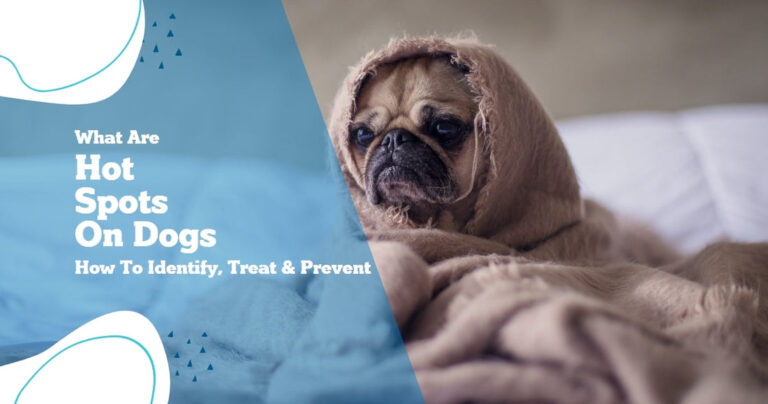A hot spot on a dog appears as a red, inflamed, and sometimes oozing area on its skin, often accompanied by hair loss and discomfort. These spots can be sensitive to the touch and may cause the dog to lick or chew at the affected area.
Hot spots, also known as acute moist dermatitis, are a common skin condition in dogs. They can be caused by various factors such as allergies, insect bites, or underlying skin infections. Identifying and treating hot spots promptly is crucial to prevent them from worsening and causing further discomfort to the dog.
We will explore the signs and symptoms of hot spots on dogs, their causes, and effective ways to manage and prevent them to ensure the well-being of your canine companion.
Hot Spot Visuals On Dogs: Key Indicators
Definition and brief description of hot spots in dogs – Hot spots are red, moist, and irritated areas on a dog’s skin that can be painful and uncomfortable. They are often caused by bacterial infections and excessive licking or scratching.
Common breeds prone to developing hot spots – Breeds with thick or long coats such as Golden Retrievers, German Shepherds, and Labrador Retrievers are more susceptible to developing hot spots due to the moisture and warmth trapped in their fur. Additionally, dogs with allergies or skin conditions may also be prone to developing hot spots.

Credit: www.animaltrust.org.uk
Identifying Telltale Signs
A hot spot on a dog appears as a red, inflamed area on the skin that can vary in size, shape, and color. It may be circular or irregular and often appears moist due to pus and oozing. Additionally, there is often hair loss around the affected area. Behavioral cues can include scratching, licking, and biting at the site. The dog may display discomfort or agitation in the presence of the irritation, manifesting as increased licking or a reluctance to be touched in the affected area.
Causes And Triggers Of Canine Hot Spots
Hot spots on dogs are typically characterized by red, inflamed areas on the skin that may be warm to the touch. These spots can occur due to a range of factors, including allergies, underlying skin infections, excessive moisture, and stress-induced licking or chewing. Allergies, particularly to environmental triggers or certain foods, are a common cause of hot spots in dogs. Additionally, skin infections such as yeast or bacteria can exacerbate the development of hot spots, leading to further discomfort for the dog. Moisture can also play a significant role, providing an optimal environment for bacterial growth. Stress or boredom-related licking or chewing can further irritate the skin, creating an ideal setting for a hot spot to develop.
Steps For Early Detection
Regular grooming is essential for early detection of hot spots on dogs. Check for any red, irritated, or moist areas on the skin, especially after outdoor activities. Establish a skin check routine to monitor any irregularities. Additionally, keep an eye out for sudden changes in your dog’s behavior, such as excessive licking, scratching, or discomfort, as these could be signs of a developing hot spot.
Managing A Dog’s Hot Spot At Home
A hot spot on a dog presents as a red, moist, and irritated area on the skin. To manage a dog’s hot spot at home, start by gently cleaning the affected area with a mild antiseptic solution. Keep the area dry and clean to promote healing and prevent further irritation. Consider using an Elizabethan collar to prevent the dog from licking or scratching the hot spot. If the hot spot does not improve within a couple of days or if it worsens, it’s important to seek veterinary care. Your vet can provide additional treatment and determine if there are underlying causes contributing to the hot spot.
Preventive Measures For Future Outbreaks
Hot spots on dogs are red, inflamed, and painful areas that can lead to discomfort and itching. To prevent future outbreaks, it’s essential to focus on the dog’s diet and nutrition. Providing a balanced diet rich in essential fatty acids can help maintain healthy skin and reduce inflammation. Additionally, incorporating anti-inflammatory remedies such as omega-3 fatty acids or turmeric can aid in preventing hot spots. Regular vet check-ups are crucial in monitoring the dog’s overall health and catching any potential issues early on. These check-ups allow veterinarians to assess the skin’s condition and provide necessary recommendations to prevent hot spots from occurring.
Frequently Asked Questions For What Does A Hot Spot Look Like On A Dog
What Are The Symptoms Of A Hot Spot On A Dog?
Hot spots on dogs may appear as red, moist, and inflamed patches on the skin. Dogs may also excessively scratch, lick, or chew the affected area, leading to further irritation and potential infection.
How Can I Treat A Hot Spot On My Dog At Home?
To treat a hot spot on your dog at home, start by trimming the area around the hot spot, cleaning it with a mild antiseptic solution, and keeping it dry. Applying a veterinary-recommended hot spot spray or cream can also help promote healing.
When Should I Take My Dog To The Vet For A Hot Spot?
If a hot spot on your dog doesn’t show signs of improvement within a day or two of home treatment, or if it appears to be getting worse, it’s best to seek veterinary care. Additionally, if your dog seems to be in pain, has a fever, or shows signs of infection, consult your vet promptly.
Conclusion
Hot spots on dogs can present as red, inflamed, and itchy areas on the skin, requiring prompt attention. Identifying the underlying cause and providing proper care is crucial for the well-being of your furry companion. Early detection and swift intervention can alleviate discomfort and expedite the healing process.
Seek veterinary assistance for persistent or severe cases.



